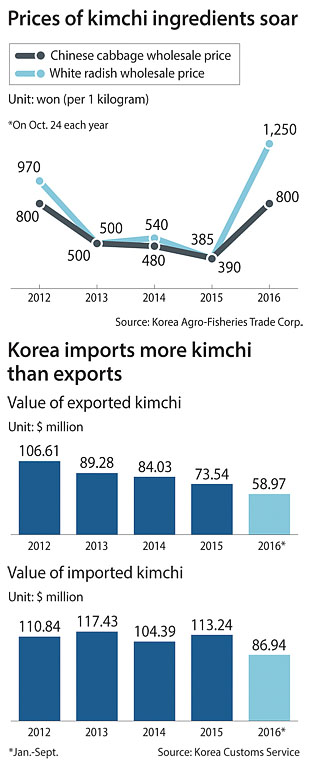Rising vegetable prices signal a pricey gimjang

Data from the state-run Korea Agro-Fisheries Trade Corp. show that the wholesale price of Chinese cabbage, the key ingredient for kimchi, was 800 won (71 cents) per kilogram on Monday. That means one cabbage, which weighs 3 kilograms (6.6 pounds) on average, costs about 2,400 won.
The price slumped 59 percent from a month earlier. Still, Monday’s price is 105 percent higher than a year earlier, when the cabbage harvest was better than previous years. A Chinese cabbage cost as much as 10,000 won at retailers ahead of the Chuseok holiday in mid-September this year.
Vegetables and seafood are affected the most by the temperature and rainfall. Neither was good this year. Days when the average daily temperature hit 34 degrees Celsius (93.2 degrees Fahrenheit) or higher totaled 22.4, the second most after 1994 at 31.1. Precipitation from late July through mid-August in Daegwallyeong, Gangwon, the main production base for Chinese cabbages, stood at 38.4 milliliters (1.3 ounces), about a mere 10 percent of the average in the past three decades.
Prices of white radish, another key ingredient in kimchi, have also shot up. Per-kilogram wholesale prices of the vegetable more than tripled from 385 won a year ago to 1,250 won.
The cost of other ingredients also have risen. Wholesale prices of jjokpa, or chives, more than doubled and oyster prices spiked 17 percent. Seafood harvests worsened over high ocean temperatures this year.
E-Mart has gone so far as to predict Chinese cabbage prices that have managed to stabilize in the past couple of months may “rebound should a cold spell to arrive earlier or any other unexpected weather conditions occur.”
“Gimjang will be 1.5 times costlier this year than last year,” the retailer said.
An average household of four prepares 20 cabbages for gimjang, the kimchi-making season that usually falls in the first three weeks of November. Last year, each household spent 215,092 won on gimjang, according to Korea Agro-Fisheries Trade Corporation.
The ever-expensive price of kimchi-making is expected to spur imports of kimchi. Even though Korea has long taken pride in being the origin of the fermented vegetable, Koreans rely heavily on kimchi made cheaper in China. A recent poll by the Ministry of Food, Agriculture, Forestry and Fisheries showed 60 percent of restaurants use kimchi shipped from China.
In the first nine months of this year, the value of imported kimchi was $86.94 million, compared to $58.97 million worth of kimchi exports, data from Korea Customs show.
The Agriculture Ministry said Monday it will devise measures to stabilize the demand and supply of kimchi ingredients.
BY SEO JI-EUN [seo.jieun@joongang.co.kr]










with the Korea JoongAng Daily
To write comments, please log in to one of the accounts.
Standards Board Policy (0/250자)